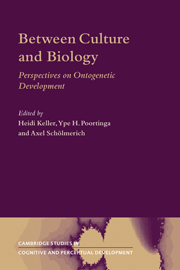Book contents
- Frontmatter
- Contents
- List of figures
- List of tables
- Notes on contributors
- Acknowledgements
- Introduction
- Part I Setting the scene
- Part II Perspectives on development informed by culture
- Part III Perspectives on development drawing from the universal and the specific
- Part IV Perspectives on development informed by evolutionary thinking
- 10 Development as the interface between biology and culture: a conceptualization of early ontogenetic experiences
- 11 Integrating evolution, culture and developmental psychology: explaining caregiver–infant proximity and responsiveness in central Africa and the USA
- 12 Shame across cultures: the evolution, ontogeny and function of a ‘moral emotion’
- Part V Metaperspectives
- Author index
- Subject index
- Cambridge Cultural Social Studies
12 - Shame across cultures: the evolution, ontogeny and function of a ‘moral emotion’
Published online by Cambridge University Press: 22 September 2009
- Frontmatter
- Contents
- List of figures
- List of tables
- Notes on contributors
- Acknowledgements
- Introduction
- Part I Setting the scene
- Part II Perspectives on development informed by culture
- Part III Perspectives on development drawing from the universal and the specific
- Part IV Perspectives on development informed by evolutionary thinking
- 10 Development as the interface between biology and culture: a conceptualization of early ontogenetic experiences
- 11 Integrating evolution, culture and developmental psychology: explaining caregiver–infant proximity and responsiveness in central Africa and the USA
- 12 Shame across cultures: the evolution, ontogeny and function of a ‘moral emotion’
- Part V Metaperspectives
- Author index
- Subject index
- Cambridge Cultural Social Studies
Summary
Our aim in this chapter is to apply a ‘dual inheritance theory’ and show how ‘emotion universals’ – in this case shame – are related to physiological processes and linked to social and behavioural similarities across cultures on the one hand and how culture-specific emotions are connected to the learning and coding of specific social and behavioural patterns and conventions on the other. At least since Paul Ekman's major studies (e.g. 1973, 1980, 1989; Ekman and Oster, 1979) on ‘basic emotions’ and the rise of the constructivist view in anthropology, there has been a controversy over whether emotions are universal or culturally constructed (Armon-Jones, 1986; Averill, 1980; Harré, 1986; Lutz, 1988). Many recent studies have shown that everywhere humans express emotions through metaphors and/or metonyms, which are related to bodily feelings (Kövecses, 1995, 1998), which in turn are generated by autonomic nervous system activities. These activities seem to have a panhuman hard-wired basis (for an overview see Levenson et al., 1992). These findings challenge the cultural constructivist hypothesis, which postulates that different cultures construct emotions in an entirely different manner. However, a comparison of the events which lead to the feelings expressed by these metaphors and metonyms shows that the antecedents and related appraisals do vary greatly between cultures.
- Type
- Chapter
- Information
- Between Culture and BiologyPerspectives on Ontogenetic Development, pp. 270 - 300Publisher: Cambridge University PressPrint publication year: 2002
- 27
- Cited by

